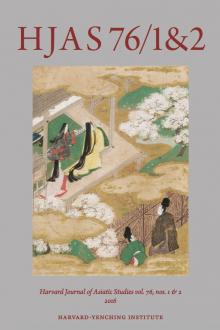June–December 2016
Details: Tosa Mitsunobu, Young Murasaki (Wakamurasaki), illustration to chap. 5, in Genji monogatari, Muromachi period, 1509–1510. Fifth of a series of 54 painted album leaves mounted in an album with calligraphic excerpts; ink, color, and gold on paper; H. 24.2 cm x W. 18.0 cm. Harvard Art Museums/Arthur M. Sackler Museum, Bequest of the Hofer Collection of the Arts of Asia, 1985.352.5.A. Photo: Imaging Department © President and Fellows of Harvard College.
Editorial Preface
In Memoriam, Philip A. Kuhn, 1933–2016
Articles
Homosocial Mentorship and the Serviceable Female Corpse
Manhood Rituals in The Tale of Genji
“The Rites” (Minori) chapter presents a pivotal event in The Tale of Genji: the death of Genji’s most beloved wife, Murasaki no Ue. In analyzing this scene, I focus on how her death magnifies melancholic attachment to strengthen ties between the bereaved male protagonists. Loss of this stunning woman lures two generations of men into a spell of deathbed fellowship. After Murasaki has died, Genji and his son, Yûgiri, together gaze at her cadaver. Such intimate viewing represents not only an instance of unchecked voyeurism but also signifies a pedagogical exercise in which beholding a dead female body fosters homosocial communion. This act stages a paternal object lesson in how to mourn and earn manhood through rituals of lurid staring. In tracing how dominative desires to look, grieve, and teach transpire in the scene, I argue that Murasaki’s flawless corpse fuels patriarchal inheritance.
紫の上の死後、光源氏と夕霧は共に彼女の亡き骸を見つめる。本稿ではその行為の果たす役割に注目したい。それは哀愁の儀式として機能し、紫の上の死を通じ、遺された二人の男のホモソーシャルな絆は強まり、夕霧の男性性が醸成されるきっかけにもなる。
Precious Bodies
Money Transformation Stories from Medieval to Late Imperial China
This article examines narrative depictions of the bizarre and often confounding transformation of inanimate copper coins, gold pieces, and silver ingots into human form. Stories of money’s transformations appear across a range of medieval and late imperial genres, from classical anecdotes and vernacular tales to northern and southern dramatic forms. In each of these traditions, the body of the animate money becomes a site for the articulation of changing understandings of value and meaning. By tracing the embodiment of money from the Six Dynasties to the Qing, this article illuminates the shifting imagination of money from object to subject, in which the increasing identification of self and silver becomes a source not of anxiety but of agency.
本文將研究六朝到清代對銅錢、金幣和銀錠化身人形這一怪異現象的描寫。從文言和白話小說到北曲南戲,通過金人幻化人形,各種有關價值轉移與生命意義的論點藉以展開。本文將揭示一種對金錢想像的歷史變化:它們從客體變主體,從人造物變成了人的創造者。
Analyzing Printing Trends in Late Imperial China Using Large Bibliometric Datasets
Online library catalog records of Chinese texts written during the late imperial period contain a wealth of traditional bibliographic information. Nearly 35,000 records on texts written from 1550 to 1799, available through WorldCat, describe these works in minute detail: the size of a page’s text frame, the number of characters per page, print quality, genre, and so on. Aggregating this bibliographic information allows for a rapid and statistically rigorous approach to quantitative print history. Diachronic analysis of the size of the text frame of the late imperial texts represented by these records reveals a rapid increase in the production of very small format texts during the latter part of the eighteenth century. When integrated with information on genre, this analysis confirms Robert Hegel’s hypothesis that novels were printed in ever smaller formats during the Qing dynasty and traces the origin of this trend to the 1750s.
各種網上圖書館目錄包含關於明清時期古籍善本的目錄學資料。 WorldCat 保存了三萬五千條從 1550 至 1799 年間所刊書籍的記錄。這些記錄包括版框面積、風格等詳細的信息。歷時性分析表明版框很小的書籍的數量在十八世紀末急劇增加,也確證何谷理關於清朝的小說印本縮小的假說。
China’s Gate to the Indian Ocean
Iranian and Arab Long-Distance Traders
Iranian and Arab merchants were among the first long-distance traders who sailed from the Persian Gulf to China. Many settled in Guangzhou or other coastal cities, establishing diaspora communities in an efficient maritime trade network, at a time when Chinese merchants were not yet actively sailing overseas. Here, I collect and comparatively analyze both textual and archaeological sources to reassess the role of Iranian and Arab merchants in initiating China’s expansion of long-distance overseas maritime commerce. Local kilns, for example, were already producing ceramics for Middle Eastern markets during the Tang. I also show evidence that attests to a much more active role of the Tang court in Sino-Arab relations than has hitherto been assumed. But corruption in local management of maritime trade and political conflicts also had far-reaching consequences on the presence of Iranian and Arab merchants in Guangzhou and the functioning of their networks.
本文將收集並通過比較分析文本材料和考古材料,重新評估伊朗和阿拉伯商人在中國海運貿易的興起中所起到的作用。作為中國長期海外貿易的發起者,他們在高效的海運貿易網絡中建立起僑民社區。證據還表明,唐朝廷在中阿關係中起著前所未料的積極作用。
